A company forfeits 100 shares of $10 each fully called upon. The shareholder has failed to pay the first call money of $3 per share and the second and final Call Money of $3 per share. Pass the journal entry. A company forfeits 100 shares of $10 each issued at $11 per share. The premium was payable on an allotment. The shareholder failed to pay the allotment money of $3 per share and the second and final call of $5 per share. Pass the journal entry. A company forfeits 100 shares of $10 each issued at $9 per share on account of non-payment of $4 per share by the shareholder. Pass the journal entry. X Ltd. issued 20,000 equity shares of $10 each at a discount of 10%. The amounts payable are: Mr. Seth, the holder of 1,000 shares, did not pay the amount due on call and his shares were forfeited by the company. Journalize the entries for forfeiture. A Ltd. had its issued capital comprising 20,000 equity shares of $10 each payable as: The shares were called up to the first call stage. All the share money was received except from John, holding 300 shares, who paid only application and except from Harry, holding 100 shares, who paid up to the allotment. All these shares were forfeited. Mr. John holds 200 shares of $10 each. He had paid on these shares application money of $2 each, allotment money of $2 each, and first call money of $3 each. He failed to pay the final call amount of $3 per share. His shares were forfeited and reissued at $8 per share as fully paid up. Give the necessary entries to record the forfeiture and reissue. A holds 10 shares of $10 each, on which he has paid $1 per share as application money. B holds 20 shares of $10 each, on which he has paid $1 on application, $2 on an allotment, and $2 on the first call. C holds 30 shares of $10 each and has paid $1 on application, $2 on an allotment, and $2 on the first call. They all fail to pay their arrears and the second call of $2 per share. Therefore, the directors forfeited their shares. The shares of C were then reissued at $7 per share as fully paid up. Pass necessary journal entries of forfeiture and reissue of shares. Alternatively, the first entry can also be passed using the following method:Forfeiture of Shares at Par
Practical Problem 1
Solution

Forfeiture of Shares at a Premium
Practical Problem 2
Solution
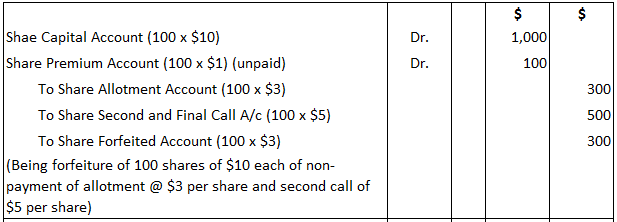
Forfeiture of Shares at a Discount
Practical Problem 3
Solution

Practical Problem 4
Solution

Practical Problem 5
Solution
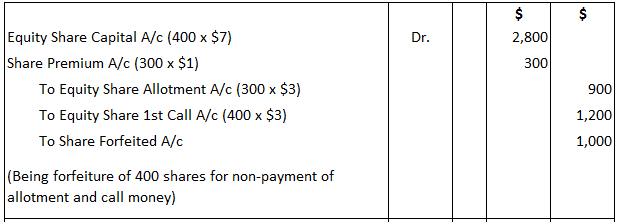
Reissue of Forfeited Shares
Practical Problem 6
Solution
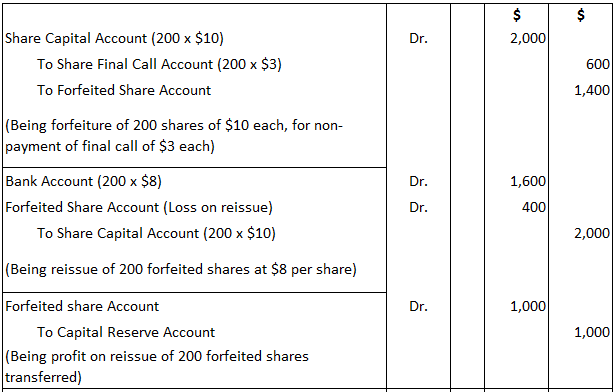
Reissue of a Part of Forfeited Shares
Practical Problem 7
Solution
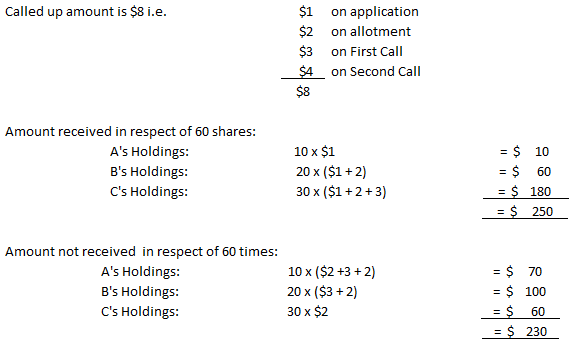
Journal
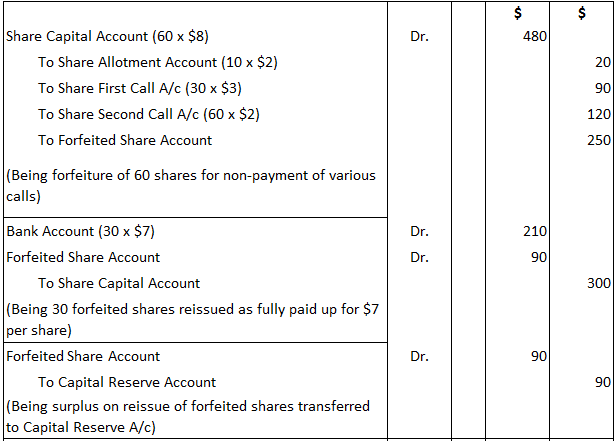


Forfeiture of Shares: Practical Problems and Solutions FAQs
Forfeiture and reissue of shares is a process by which the company reclaims shares from a shareholder and then issues them to another party. This typically occurs when the company wants to enforce its rights or when the shareholder has violated a term of their agreement.
The consequences of forfeiture of shares vary depending on the situation but can include termination of ownership, loss of voting rights, and being barred from future participation in the company. In some cases, the company may also be able to recover any outstanding debts that the shareholder owes.
It typically involves notifying the shareholder of the company's intention to reclaim the shares, providing them with an opportunity to respond, and then making a decision based on that response. If the company decides to move forward with the reissue of shares, they will typically need to identify a new shareholder to take ownership of them.
Forfeiture of shares can impact the company in several ways, including by reducing the number of shareholders, increasing the percentage of ownership held by other shareholders, and impacting the company's ability to raise capital. It can also create complications for the company if it needs to enforce its rights against the former shareholder.
The journal entry for forfeiture of shares will vary depending on the situation but may include a debit to shareholder equity for the value of the forfeited shares and a credit to accounts receivable or cash for any outstanding debts that the shareholder owes.
True Tamplin is a published author, public speaker, CEO of UpDigital, and founder of Finance Strategists.
True is a Certified Educator in Personal Finance (CEPF®), author of The Handy Financial Ratios Guide, a member of the Society for Advancing Business Editing and Writing, contributes to his financial education site, Finance Strategists, and has spoken to various financial communities such as the CFA Institute, as well as university students like his Alma mater, Biola University, where he received a bachelor of science in business and data analytics.
To learn more about True, visit his personal website or view his author profiles on Amazon, Nasdaq and Forbes.











